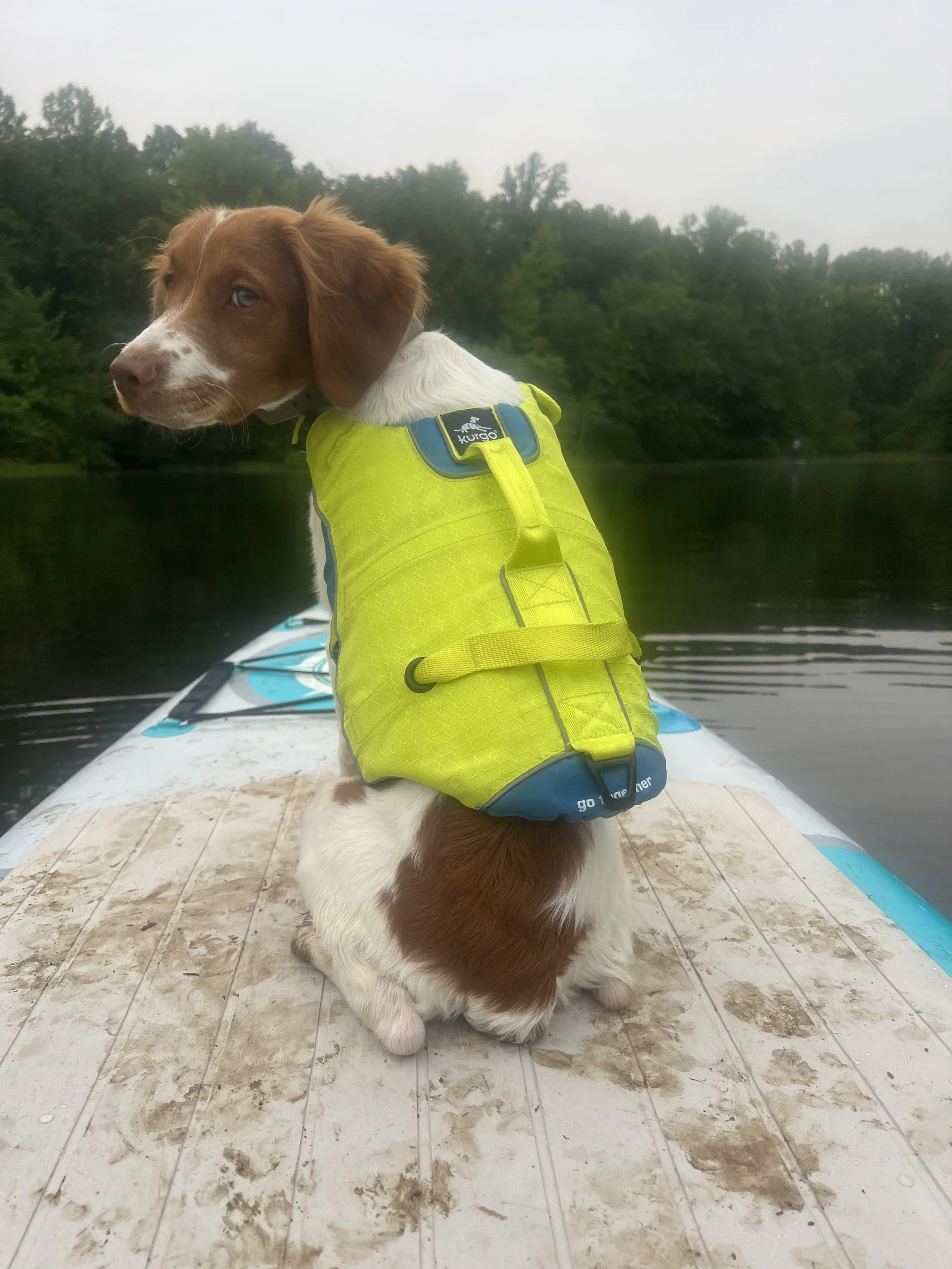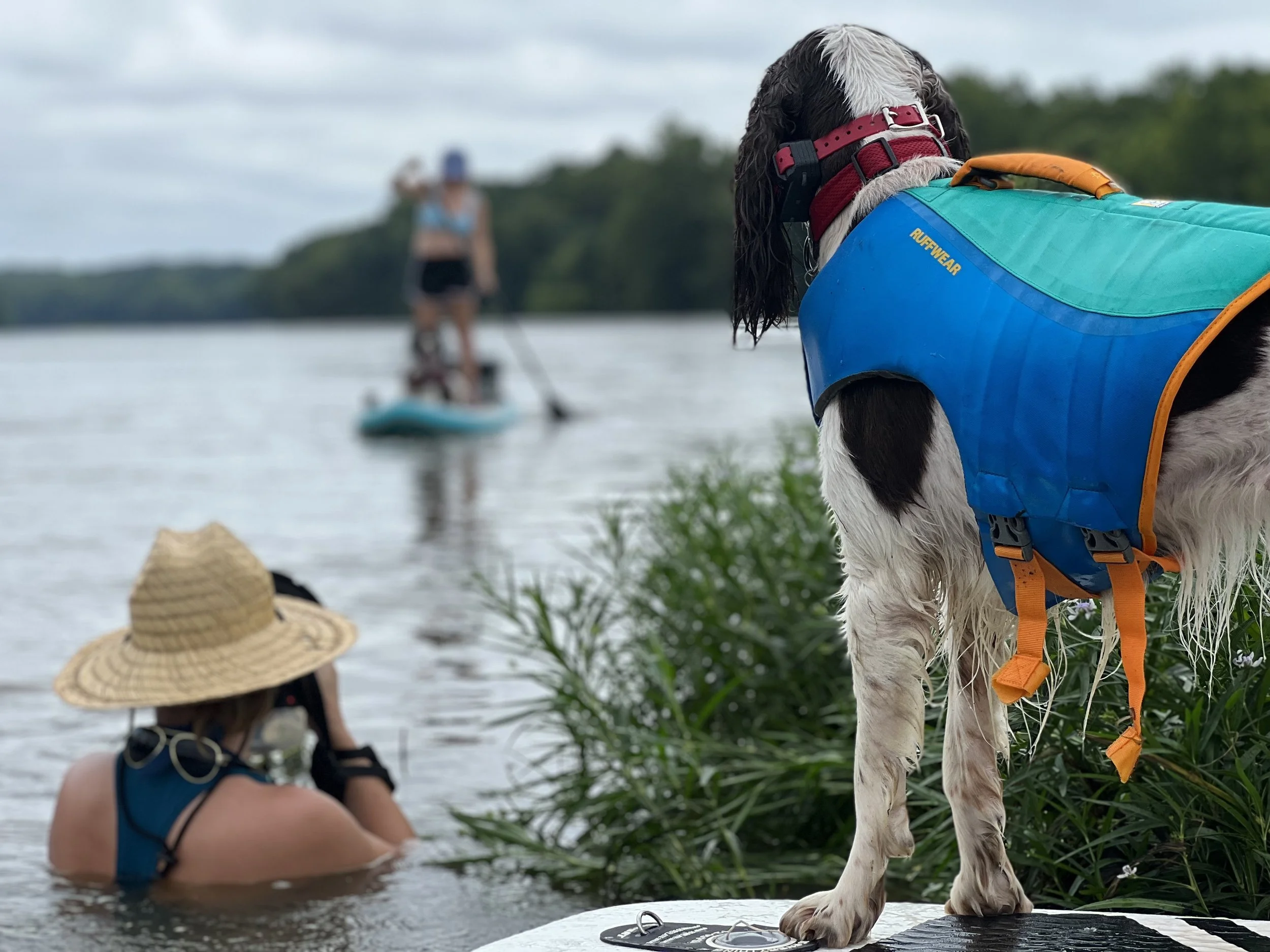Sup Pup! Tips for paddleboaring with your dog.
One of mine and Cedar’s favorite summer activities is getting out on the water with our paddleboard. In this blog, I’ll give a brief overview of how I get a dog acclimated to the board and key takeaways.
1: Reality Check
Now I know some of you may not want to hear this, but I’mma say it anyway. Not every dog (or human) is down for being on the water. Take an objective look at your and your dog’s health, ability, comfort level, and desire to do this.
I remember the day I made the heartbreaking decision that Kona was unable to join me anymore due to her age and mobility/stability concerns. That decision came from her almost drowning.
Looking back, I was in denial about her limitations. I knew her hips were going but I blinded myself to just how bad they were.
I took her out to Belle Isle to shoot the cover of my book, Tails of the River City, and pushed her a little too hard.
She rocked the session, and I got it in my head that she was fine enough standing on the board for some more photos and paddling around with me.
Turns out, she had given me all she had and I didn’t recognize she needed to get back on land. I gently turned the board to get a better angle, but that was enough to cause her to lose her balance and fall in. And struggle to keep her nose from going under.
I was able to get to her in time, but that was a huge wake-up call for me.
2: Safety First
Even if your dog is an expert swimmer, a life jacket is always recommended. In addition to keeping your dog floating, the handle will help you get your pup back on the board.
Cedar wears the Kurgo Surf & Turf Life Jacket, Deeks wears the Ruffwear Float Coat and I’ve been dying to try out the Non-stop Dogwear Protector Life Jacket
Don’t forget your own life jacket too! You can/will be ticketed for not having one on your board.
I use the ONYX M-16 Manual Inflatable Belt Pack Life Jacket.
Make sure you check the weather and water levels before you head out, and always let someone know where you are going and when you plan to be back.
3. Choosing the right board
Let’s talk about inflatable vs rigid boards for a second. While rigid boards may be more agile and faster, I like inflatable boards overall due to the ease of transport and storage, and durability.
They also provide more of a ‘cushion’ that I feel works well for helping with Cedar’s stability. Most inflatable boards on the market are super durable and puncture-resistant. Opt for wide boards which allow for more stability, especially if you are paddling with more than one pup.
My board is 10’6 and about 34’’ wide. iRocker has a great article about choosing the best-sized paddleboard for your needs. Check it out here.
4. Practice on dry land first
Acclimate your pup to the board on dry land first. I like to use cheese or other high-value treats and just practice having them stand and sit on the board. Having a good “place” or “stay” command is extremely helpful.
I’ll also get on the board and practice paddling (making sure the pup is okay with the paddle going over their head) along with rocking side to side.
5. Shallow water introduction
I like to start in the shallows so I can stand there and hold the board while the pup gets used to how the board feels on the water.
This is where I’ll start enforcing the place command. I like Cedar either directly in front of me, in the middle of the board (where the handle is) or at the front of the board. I will never allow her to ride behind me.
6. Short, positive trips
Until they are super comfortable and confident on the water, start with shorter trips. Always make it a positive experience, with lots of treats or other rewards for your pup.
If they start to shut down, don’t push it. Call it a day, paddle to the shore, reward your pup, and try again another day.
The most important thing is to always end on a positive note!
7. Get ready to fall
Listen, unless you’ve been paddling your whole life and your dog has a SOLID stay, be prepared to fall in. And even still, your pup is bound to knock you in — accidentally or not. (I swear, Deeks like to make sure I fall off so he can chill on the board on his own.)
Know that when your pup inevitably jumps from the board, the momentum is going to push the board out from under you. If you can see it coming, you can brace yourself and at least fall to your knees, instead of off the board completely.
I like to practice falling in and getting myself and Cedar back on the board at the start of every season, just to make sure it comes second nature when it does actually happen.
Start practicing first in an area where you can touch the bottom, but also practice where you can’t touch. This is where having a life jacket (on you and your pup) comes in really handy.
8. Don’t forget to have fun!
Being out on the water should be a fun, relaxing, enjoyable time. If you or your dog aren’t having a good time, it’s always okay to head home and try again another day. Don’t push yourself or your pup too hard, especially if you are also learning how to balance, too. It’s okay to stay seated or just kneel to start.
9. Ask questions
While I have something cool in the works, I’m not sure it’ll be ready by the end of this season. So feel free to email me with any questions you may have, related to you or your pup gaining confidence on the board.
info@kristenjmurray.com
Happy Paddling!






